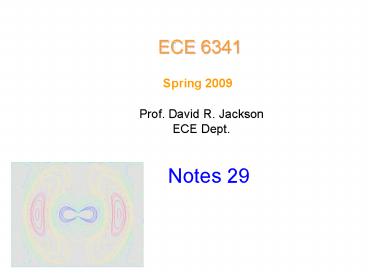Prof. David R. Jackson - PowerPoint PPT Presentation
1 / 22
Title:
Prof. David R. Jackson
Description:
Specular point. The specular point of reflection is the point at which the ray ... Specular point. Proof. Then. High-Frequency Scattering by Cylinder (cont. ... – PowerPoint PPT presentation
Number of Views:53
Avg rating:3.0/5.0
Title: Prof. David R. Jackson
1
ECE 6341
Spring 2009
Prof. David R. Jackson ECE Dept.
Notes 29
2
High-Frequency Scattering by Cylinder
PEC cylinder
Assume
3
Physical Optics
Physical Optics Approximation
lit
dark
normal
dark side (not seen by incident plane wave)
4
Physical Optics (cont.)
Physical Optics Approximation
lit
dark
Locally, the reflection acts like plane-wave
reflection from a flat surface.
normal
Lit side
5
Physical Optics (cont.)
Physical Optics Approximation
lit
dark
Lit side
Dark side
6
High-Frequency Scattering by Cylinder (cont.)
Physical Optics Approximation
lit region
PEC
lit
7
High-Frequency Scattering by Cylinder (cont.)
or
8
High-Frequency Scattering by Cylinder (cont.)
Scattered field
Consider a z-directed line source at the origin
9
High-Frequency Scattering by Cylinder (cont.)
Far field
Scattered field
Next, consider the line source to be located at
(x, y)
For current at , include phase
shift terms
10
High-Frequency Scattering by Cylinder (cont.)
or
Hence, letting
Hence
or
or
11
High-Frequency Scattering by Cylinder (cont.)
Hence
Integrating,
For the integral
12
High-Frequency Scattering by Cylinder (cont.)
This may be written as
Hence
where
Compare with
For the integral
Hence, we can identify
13
High-Frequency Scattering by Cylinder (cont.)
Find the stationary-phase point
SPP
or
A
B
(Assume ? ? 2? n)
14
High-Frequency Scattering by Cylinder (cont.)
We require the restriction that
(b)
From the previous slide,
Also,
since
choose
Hence, choose n -1
15
Geometrical Optics
Specular point
The specular point of reflection is the point at
which the ray reflects off and travels to the
observation point.
observation point
We can show that
specular point
16
Geometrical Optics (cont.)
Specular point
Proof
17
High-Frequency Scattering by Cylinder (cont.)
Note that there is always a stationary-phase
point, for all observation angles (except ? 0)
Then
18
High-Frequency Scattering by Cylinder (cont.)
Next, calculate the g function at the
stationary-phase point
At SPP
19
High-Frequency Scattering by Cylinder (cont.)
At SPP
Next, calculate the second derivative of the g
function
Note
20
High-Frequency Scattering by Cylinder (cont.)
Hence the integral is
Hence
or
or
21
High-Frequency Scattering by Cylinder (cont.)
Recall
Then
Therefore
or
or
22
High-Frequency Scattering by Cylinder (cont.)
Then































